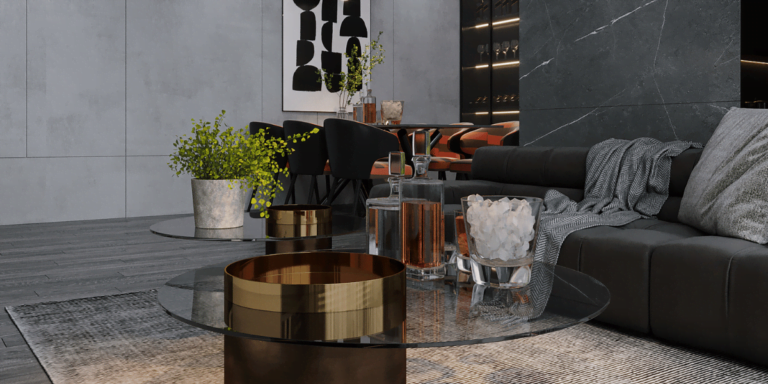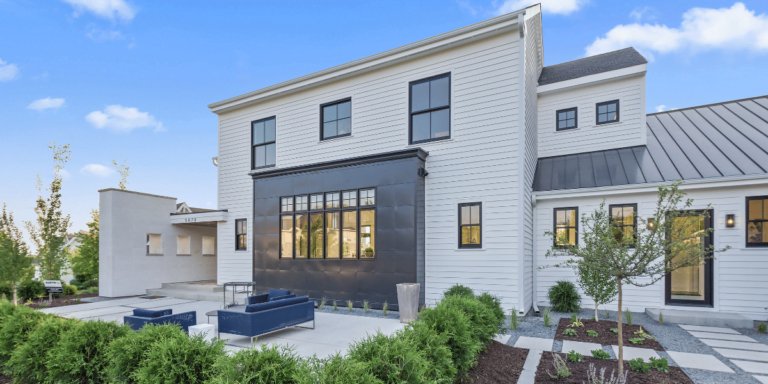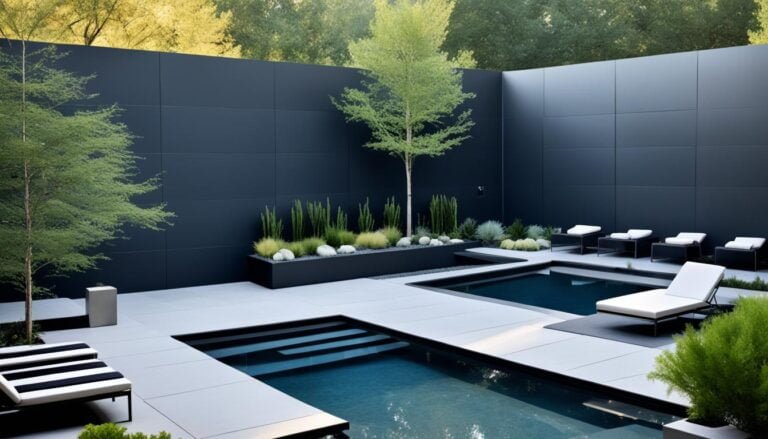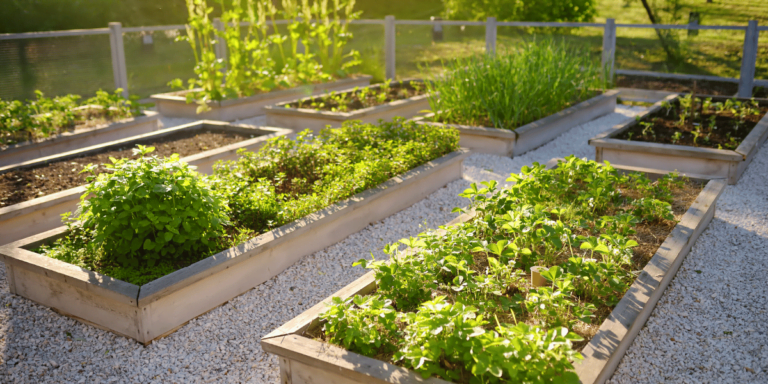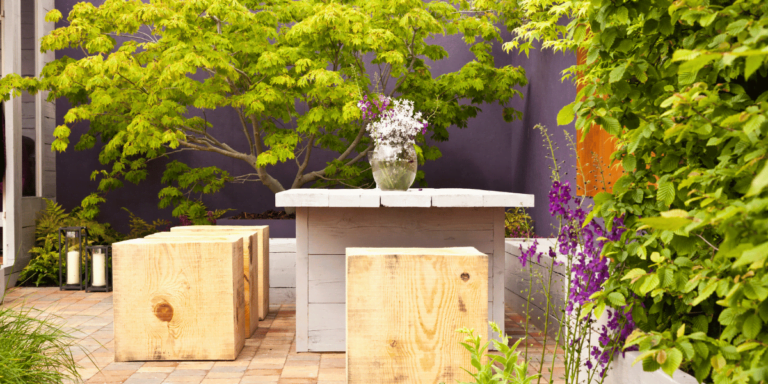Are you looking to bring greenery into your small garden or urban space? With space-saving planters, you can transform even the tiniest areas into a lush green retreat. Whether you have a small apartment, balcony, or tiny yard, container gardening and vertical gardening techniques are the perfect solutions.
Container gardening allows you to utilize every inch of space by growing plants in pots and containers. By going vertical, you can maximize your available wall space and grow plants that climb or hang. Whether you want to cultivate herbs on your windowsill, add bursts of colorful blooms to your balcony, or even grow dwarf fruit trees, there is a space-saving planter option for every small garden.
So, let’s explore the world of space-saving planters and discover how you can create a thriving garden in your limited space.
Key Takeaways:
- Container gardening and vertical gardening are perfect for small spaces.
- Utilize vertical space by growing plants that climb or hang.
- Herbs can be grown in small pots on windowsills.
- Colorful blooms can be added to balconies using lightweight planters.
- Dwarf fruit trees can thrive in containers, even in small yards.
Utilizing Vertical Space
When space is limited, thinking vertically is key. Utilizing vertical space through vertical gardening techniques can help maximize the available area for growing plants. By incorporating climbing plants, trellises, and hanging containers, you can effectively utilize wall space and create a lush and vibrant garden in your small space.
Vertical gardening involves growing plants vertically, providing an innovative solution for small gardens, balconies, or even indoor spaces. It offers a way to maximize floor space while still enjoying the beauty and benefits of a thriving garden.
Maximizing Wall Space with Trellises
Trellises are versatile structures that can be attached to walls, fences, or freestanding frames. You can train climbing plants to grow vertically along the trellis, creating a stunning green backdrop. Not only does this add visual interest, but it also helps maximize the amount of space available for planting.
Climbing plants such as ivy, morning glories, and compact fruit-bearing varieties like varieties like strawberries are perfect for trellises. These plants can add beauty and color to your space while minimizing the need for horizontal planting areas.
Hanging Containers for Vertical Gardening
Hanging containers are another effective way to utilize vertical space. You can suspend containers from walls, railings, or overhead structures, allowing plants to grow downwards. This technique is particularly useful for trailing plants or those with cascading foliage.
Consider using hanging containers for herbs, small flowering plants, or even a vertical succulent garden. By hanging containers at varying heights, you can create an eye-catching visual display while still making the most of your limited space.
Creating a Visual Focal Point
When implementing vertical gardening, it’s important to consider the aesthetics. Use different types of vertical planters, such as trellises and hanging containers, to create a visually appealing focal point in your garden or balcony. This will not only optimize your space but also enhance the overall ambiance of your small garden oasis.
To inspire you, here’s an image showcasing the beauty of vertical gardening:
Growing Herbs in Small Spaces
When it comes to small-scale container gardening, herbs are a perfect choice. Not only do they add a touch of greenery to your small space, but they also provide a fresh supply of aromatic flavors for cooking enthusiasts. Whether you have a windowsill, a balcony, or even a shelf, you can easily grow your own herb garden.
Basil is a popular herb that thrives in small pots. Its vibrant green leaves and distinctive aroma make it a staple in many recipes, from pasta dishes to salads. It’s incredibly versatile and can be grown indoors or outdoors, as long as it receives adequate sunlight.
Mint is another herb that adapts well to small containers. It’s known for its refreshing flavor and fragrance, adding a burst of freshness to beverages, desserts, and savory dishes. Mint is a fast grower, so be sure to place it in a container that allows room for its spreading roots.
Rosemary is a popular herb that adds a savory and aromatic touch to a wide range of dishes, including roasted meats, potatoes, and soups. This woody perennial herb thrives in small pots, making it a perfect choice for small spaces like windowsills or balconies.
Thyme is a versatile herb with a unique flavor profile that blends well with various dishes. It complements meats, stews, and vegetables, making it a must-have herb in every kitchen. As a low-growing and compact herb, thyme is well-suited for small containers and windowsill gardening.
To optimize space and ensure the best growing conditions, consider using herb containers specifically designed for small spaces. These containers are typically compact, lightweight, and have proper drainage to prevent waterlogging. Additionally, they add a decorative touch to your small space.
If you don’t have access to an outdoor space, windowsill gardening is a great alternative for growing herbs. Place your herb containers near a sunny window, where they can receive at least six hours of sunlight per day. Remember to water your herbs regularly and provide adequate airflow to prevent issues such as mold or mildew.
Benefits of Growing Herbs in Small Spaces:
- Provides a fresh supply of aromatic flavors for cooking enthusiasts
- Optimizes limited space with compact herb containers
- Easy access to fresh herbs for cooking and garnishing
- Enhances the visual appeal of small spaces with lush greenery
- Contributes to a sustainable lifestyle by reducing reliance on store-bought herbs
Recommended Herbs for Small-Scale Gardening
| Herb | Growth Habit | Preferred Growing Conditions | Uses in Cooking |
|---|---|---|---|
| Basil | Compact, bushy | Sunny location, well-drained soil | Pasta, salads, pesto |
| Mint | Spreading | Partial shade, moist soil | Beverages, desserts, salads |
| Rosemary | Woody, upright | Sunny location, well-drained soil | Roasted meats, potatoes, soups |
| Thyme | Low-growing | Sunny location, well-drained soil | Meats, stews, vegetables |
Adding Colorful Blooms to Your Balcony
Elevate your balcony with a burst of colors by planting flowers in containers. Colorful blooms not only brighten up your outdoor space but also bring joy and beauty to your everyday life. Balcony gardening offers a unique opportunity to create a vibrant oasis right outside your window, even in a limited space.
Flowers that flourish in containers: Petunias, geraniums, and marigolds are excellent choices for balcony gardening. These versatile plants thrive in containers and are known for their stunning array of vibrant hues and captivating blooms. They add a pop of color to your balcony, instantly transforming it into a picturesque escape.
Lightweight and stylish planters: When selecting planters for your balcony, opt for lightweight options that are easy to move around. This allows you to rearrange your plants and experiment with different layouts to create a visually appealing display. Choose planters that complement your balcony’s style, whether it’s modern, rustic, or eclectic.
Trailing plants for added beauty: To make the most of your balcony space, consider incorporating trailing plants into your floral arrangement. Trailing plants, such as ivy or cascading petunias, can cascade from hanging baskets or spill over the edges of planters, adding a dynamic and lush look to your balcony garden.
Adding colorful blooms to your balcony not only enhances the aesthetics of your outdoor space but also creates a welcoming and lively atmosphere. Whether you have a small balcony or a spacious terrace, the sight of colorful flowers can uplift your mood and provide a soothing escape from the hustle and bustle of daily life.
Cultivating Dwarf Fruit Trees
Surprisingly, dwarf fruit trees can thrive in containers, even in small yards or on balconies. Compact apple, citrus, and pear trees are specially designed for container gardening, making them perfect for small spaces. With proper care and adequate sunlight, you can enjoy a delightful harvest of fresh fruits without needing a large outdoor garden.
Dwarf fruit trees offer a practical and enjoyable way to have a mini orchard in your backyard or balcony. They not only provide the pleasure of growing your own fruit but also add beauty and charm to your small space. The controlled size of these trees allows you to easily manage their growth and maintenance, making them ideal for container gardening.
When selecting dwarf fruit tree varieties for your small space, consider the following factors:
- Choose trees that are specifically labeled as suitable for containers.
- Consider the climate and sunlight requirements of the fruit tree.
- Opt for self-pollinating varieties to ensure fruit production.
- Research the ultimate size of the tree to ensure it will fit comfortably in your container and small space.
Once you’ve chosen your dwarf fruit tree, it’s time to prepare a suitable container. Make sure the container has proper drainage holes and is large enough to accommodate the tree’s roots. Fill the container with a well-draining potting mix and place the tree in the center.
Regular watering and fertilizing are essential for the health and productivity of your dwarf fruit tree. Monitor the moisture level of the soil and water accordingly to keep it consistently moist but not waterlogged. Apply a balanced fertilizer during the growing season to provide essential nutrients.
Remember, while dwarf fruit trees are adaptable to containers, they still require adequate sunlight. Ensure that your tree receives at least 6-8 hours of direct sunlight each day for optimal growth and fruit production.
With patience and proper care, you’ll be rewarded with a bountiful harvest of fresh fruits from your dwarf fruit tree. Whether you have a small yard, balcony, or limited outdoor space, container gardening allows you to enjoy the beauty and benefits of growing your own fruit in a compact and manageable way.
Creating Low-Maintenance Succulent Arrangements
Succulents are beloved for their stunning appearance and minimal care requirements, making them a perfect choice for small spaces. Whether you have a tiny apartment or a compact balcony, you can easily create captivating succulent arrangements that add a touch of greenery to your surroundings. By combining different varieties of low-maintenance succulents and experimenting with various containers, you can design unique displays that suit your style and space.
When it comes to succulent arrangements, the possibilities are endless. From classic pots to modern low bowl planters, you can choose containers that complement your aesthetic preferences. The key is to select containers with proper drainage to prevent waterlogged soil, as succulents thrive in well-draining conditions.
Here are a few ideas to inspire your succulent arrangements:
- Create a lush centerpiece by arranging a combination of succulents in a large, shallow container. This vibrant display will instantly enhance any table or mantel.
- Design a vertical succulent garden using a wall-mounted frame or a hanging planter. This unique arrangement adds a stunning focal point to your space while maximizing vertical space.
- Add a touch of whimsy to your garden by planting succulents in vintage teacups or small decorative containers. These charming arrangements are perfect for windowsills or small nooks.
- Create a striking contrast by combining different textures and colors of succulents in a single arrangement. This visually stunning display adds depth and visual interest to your space.
What makes succulents even more appealing for small spaces is their hardiness. These resilient plants can tolerate drought-like conditions, making them ideal for busy urban residents who may not have much time for plant care. With just a little watering and occasional sunlight, your succulent arrangements will thrive and bring a touch of nature to your small space.
By incorporating low-maintenance succulent arrangements into your small space, you can enjoy the beauty of greenery without the hassle of extensive care. These hardy plants are perfect for adding a modern and stylish touch to your home, office, or outdoor area. Whether you create a small succulent garden or scatter individual arrangements throughout your space, these plants will undoubtedly bring joy and tranquility to your surroundings.
Designing a Peaceful Zen Garden
Creating a Zen garden in a small space is a wonderful way to bring tranquility and harmony into your surroundings. By incorporating elements of container gardening and minimalist design, you can design a serene Zen garden that promotes relaxation and meditation.
In a shallow container, arrange ornamental grasses, pebbles, and small sculptures to create a minimalist setup that embraces the essence of Zen philosophy. The simplicity of the design allows for focus and mindfulness, while the natural elements contribute to a sense of peace and serenity.
A Zen garden serves as a peaceful sanctuary right in the comfort of your own home. It provides a space for quiet contemplation and serves as a reminder to embrace simplicity in all aspects of life. Spending time in a Zen garden can help reduce stress, promote mindfulness, and foster a deeper connection with nature.
So, carve out a small corner of your space and create your own Zen oasis. Let the Zen garden be a retreat where you can escape from the hustle and bustle of daily life and find peace within.
Why Choose Container Gardening for Your Zen Garden?
Container gardening is an ideal choice for designing a Zen garden due to its versatility and ease of maintenance. By using shallow containers, you can create a compact and well-contained Zen garden that fits perfectly in your small space.
Benefits of Ornamental Grasses in a Zen Garden
Ornamental grasses are essential elements in a Zen garden, adding movement, texture, and a sense of natural beauty. These grasses sway gently in the wind, creating a calming effect and enhancing the overall ambiance of your Zen garden.
Recommended Ornamental Grasses for a Zen Garden
| Grass Variety | Growth Height | Special Features |
|---|---|---|
| Japanese Forest Grass (Hakonechloa macra) | 8-16 inches | This grass has beautiful arching foliage that comes in various shades of green and gold. |
| Fountain Grass (Pennisetum spp.) | 2-5 feet | The feathery plumes of this grass add elegance and movement to your Zen garden. |
| Maiden Grass (Miscanthus sinensis) | 4-10 feet | With its graceful arching foliage and silvery plumes, this grass creates a stunning focal point. |
Add these recommended ornamental grasses to your Zen garden and enjoy their peaceful beauty as they sway in the breeze, enhancing the overall tranquility of your space.
Conclusion
In conclusion, utilizing space-saving planters is an innovative solution for small gardens and urban spaces to bring greenery into even the most limited areas. Whether you choose to maximize vertical space, grow herbs in small pots, add a splash of color with vibrant blooms on your balcony, cultivate dwarf fruit trees, create low-maintenance succulent arrangements, design a Zen garden, or combine these ideas, the possibilities are endless. With the right planters and a touch of creativity, small spaces can be transformed into thriving and lush green retreats.
Space-saving planters allow you to create a beautiful oasis in your small space, providing a sense of tranquility and connection with nature. By incorporating these planters, even the smallest gardens can become a haven for relaxation and enjoyment. Whether you have a tiny apartment, a modest balcony, or a small urban yard, you have the power to bring the magic of greenery into your surroundings.
So, why wait? Start exploring the world of space-saving planters and unlock the beauty of greenery in your small space today. With a little creativity, dedication, and the right planters, you can transform your small garden, balcony, or urban space into a sanctuary filled with life, color, and the soothing touch of nature.
Frequently Asked Questions
What are space-saving planters?
Space-saving planters are containers designed to maximize vertical space and allow you to grow plants in small gardens or urban environments with limited space.
How can I utilize vertical space in my garden?
You can utilize vertical space in your garden by using trellises or hanging containers to grow climbing plants and compact fruit-bearing varieties. This helps maximize floor space and allows you to grow more plants without taking up valuable horizontal space.
What are the best plants for small-scale container gardening?
Herbs are an excellent choice for small-scale container gardening. They thrive in small pots and can be grown on windowsills, balconies, or shelves. Basil, mint, rosemary, and thyme are versatile herbs that provide a fresh supply of aromatic flavors for cooking enthusiasts.
How can I add colorful blooms to my balcony?
You can add colorful blooms to your balcony by planting flowers in containers. Petunias, geraniums, and marigolds flourish in containers and bring vibrant hues to your outdoor space. Opt for lightweight and stylish planters that match your balcony’s style and consider trailing plants to optimize space.
Can I cultivate fruit trees in small yards or on balconies?
Yes, you can cultivate dwarf fruit trees in containers, even in small yards or on balconies. Compact apple, citrus, and pear trees are specially designed for containers. With proper care and adequate sunlight, you can enjoy a delightful harvest of fresh fruits in your small space.
Are succulents suitable for small spaces?
Yes, succulents are perfect for small spaces. They are known for their easy care and striking appearance. You can create captivating succulent arrangements with a variety of succulents in different containers, from classic pots to modern low bowl planters. These hardy plants are perfect for busy urban residents who want to add a touch of greenery to their small space without much maintenance.
How can I create a peaceful Zen garden in my small space?
You can create a peaceful Zen garden in your small space by arranging ornamental grasses, pebbles, and small sculptures in a shallow container. This minimalist setup offers a serene space for relaxation and meditation in the comfort of your own home.
How can I bring greenery into small spaces?
You can bring greenery into small spaces by using space-saving planters. Whether you utilize vertical space, grow herbs in small pots, add colorful blooms to your balcony, cultivate dwarf fruit trees, create low-maintenance succulent arrangements, design a Zen garden, or combine these ideas, there are endless possibilities to transform your small space into a thriving and lush green retreat.





